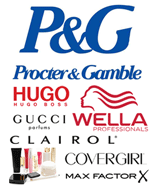 Prospective acquirers are now diving into the details on the soon-to-be former brands of Procter & Gamble’s struggling beauty business. The assets reportedly include small yet prestigious fragrance brands, such as Gucci and Hugo Boss, the substantial professional and retail hair care businesses of Wella and Clairol, and the legendary Max Factor and Cover Girl color cosmetic brands. While this partial dismantling of P&G’s beauty empire ends an era of the company’s impressive growth trajectory in personal care, it sets the stage for exciting growth opportunities for strategic and financial buyers. The beauty research and consulting team at Kline has a unique and deep perspective on the history, performance, and potential of this array of brands, as well as what the future may look like for the new owners of these P&G equities.
Prospective acquirers are now diving into the details on the soon-to-be former brands of Procter & Gamble’s struggling beauty business. The assets reportedly include small yet prestigious fragrance brands, such as Gucci and Hugo Boss, the substantial professional and retail hair care businesses of Wella and Clairol, and the legendary Max Factor and Cover Girl color cosmetic brands. While this partial dismantling of P&G’s beauty empire ends an era of the company’s impressive growth trajectory in personal care, it sets the stage for exciting growth opportunities for strategic and financial buyers. The beauty research and consulting team at Kline has a unique and deep perspective on the history, performance, and potential of this array of brands, as well as what the future may look like for the new owners of these P&G equities.
While P&G began its pursuit of beauty with its highly successful acquisition of Richardson-Vicks (Olay, Pantene) for a mere $1.2 billion in 1985, it raised its game substantially with the purchase of the long-coveted Clariol business from Bristol-Myers Squibb for an impressive $4.95 billion in 2001—at a multiple of three times sales. While Clairol is indeed a distant number two to L’Oréal in retail hair colorants, “it benefits from strong consumer awareness and heritage in the category,” according to Carrie Mellage, head of Kline’s Market Research & Reports practice in Beauty. “In professional hair care, however, Clairol has lost share,” noted Mellage, based on her team’s research and data provided in Kline’s Salon Hair Care global database and report series. “In terms of value and growth, we believe that the Clairol equity is a great one with a positioning that appeals to women globally,” added Susan Babinsky, head of Kline’s Management Consulting practice in consumer products. Babinsky also noted that “by focusing efforts on the space that Clairol does indeed own, the brand has the opportunity to revitalize growth.”
P&G’s next big move in hair care came with the $7 billion acquisition of the privately-held and family-owned Wella business in 2003. According to Kline’s Eric Vogelsberg, head of the firm’s M&A practice, that transaction was significant for “its sheer size and because it gave P&G a solid number two position in the global professional hair care industry.” Today, Wella continues as the clear number two player “with strong footholds in Europe and the hair coloring category in particular,” cited Mellage. Both Mellage and Babinsky agree that Wella has growth potential in professional hair care, particularly in developing country markets. Mellage further noted, “Wella has an excellent reputation in the professional hair care industry and is well-respected for its product technology and commitment to education and training of salon stylists.” The innovative Nioxin brand, which is a leading range of products for thinning hair, is also included in the professional portfolio. Babinsky commented, “Nioxin is one of the true treasures in this offering. This space has always had strong consumer needs, and Nioxin offers a very credible efficacy story.”
Other important brand assets included in P&G’s offering are two popular color cosmetic brands, Cover Girl and Max Factor. With its 1989 acquisition of Noxell for a stock swap transaction valued at $1.3 billion, P&G entered the makeup market via the then number one mass brand Cover Girl. While Cover Girl continues today as a highly successful brand with a share of about 20% of the $6 billion U.S. mass market, it has lost ground in particular to L’Oréal, “which has grown substantially via its own L’Oréal Paris brand and its acquired Maybelline brand,” according to Kline’s annual industry report Cosmetics & Toiletries USA. “The opportunity is to build this brand franchise globally,” remarked Babinsky. “P&G was unable to accomplish that. Cover Girl does have a differentiated position, but has perhaps become too reliant on celebrities to promote the brand. Every woman can be a Cover Girl in a way that is true to how she views herself—that message is universal.” Max Factor, the other cosmetic brand available from P&G, is much more important internationally, having exited the United States in 2009. Mellage noted, “P&G acquired Max Factor along with the Betrix business from Revlon in 1991 for $1.14 billion.” Today, Max Factor is sold in Europe, Asia, and Latin America, where it continues to be recognized for its heritage as one of the original makeup artist brands.
The third area of products included in P&G’s assets for sale is its portfolio of prestige fragrance brands, most of which are licensed offerings of high-end fashion brands, such as Dolce & Gabbana, Gucci, Hugo Boss, and others. “In the U.S. market, P&G’s prestige fragrance brands deliver over $500 million in retail sales,” said Mellage, according to the detailed brand sales data provided in Kline’s Cosmetics & Toiletries USA report and database. Babinsky noted that the “brands also generate substantial sales in international markets, where P&G needs to rely on distributors to reach retail customers. There are indeed opportunities for further international growth and synergies, which can be realized with certain buyers.”

